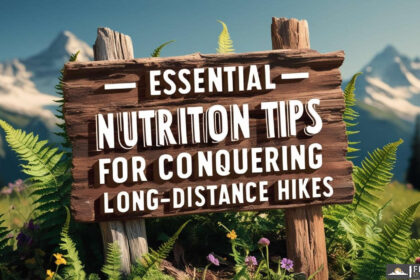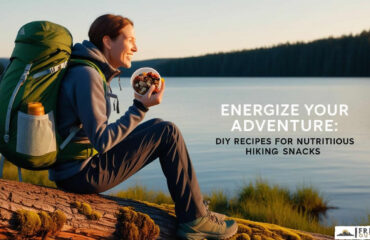
Nutrition tips for long-distance hikers to maintain energy, hydration, and meal planning for an enjoyable trekking experience.
Nutrition Tips for Long-Distance Hikers
1. Importance of Balanced Nutrition
Balanced nutrition is crucial for maintaining energy and endurance during long hikes. Hikers need a fuel strategy that typically requires a caloric intake ranging from 5,000 to 7,000 calories per day, varying based on individual mileage and body composition. A well-balanced diet should ideally include about 45-55% carbohydrates, 35-40% fats, and 10-15% protein. For instance, a hiker who consumes a diet primarily high in fats (around 70%) and moderate in carbs (20%) can maximize calorie density while minimizing the weight of their packs, ensuring they have enough energy for their journey.
Regular meal consumption is vital to prevent energy fluctuations that could lead to fatigue and hunger during strenuous activities. By adjusting caloric intake based on the intensity and duration of hiking, individuals can maintain adequate energy levels throughout their trek, allowing for an enjoyable experience without the burden of hunger or exhaustion.
2. Essential Foods to Pack
When preparing for long-distance hiking, choosing energy-dense foods is paramount. Options like nuts, dried fruits, and granola bars are highly recommended as they provide substantial calories without adding significant weight to your pack. Additionally, freeze-dried meals offer lightweight and nutritious alternatives that are easy to prepare, making them ideal for the trail. Including high-calorie snacks, such as trail mix and energy bars, is necessary to meet the energy demands of rigorous hiking.
It’s also beneficial to pack whole foods like fresh fruits and vegetables early in the hike, as they offer maximum nutritional value before perishing. For instance, eating a fresh apple or carrot sticks at the start of a hike can deliver vitamins and hydration, providing a great energy boost before getting into the more calorie-dense options later on. Incorporating a variety of food textures and flavors keeps meals interesting and enhances overall motivation on the trail.
3. Hydration Strategies
Hydration is vital during long hikes, and hikers should aim to consume at least 4 cups of water before starting their trek, in addition to planning for 2 cups of fluid per hour of activity. Electrolyte packets can also be beneficial for maintaining hydration and energy levels, especially during extended outings. Monitoring urine color is a simple yet effective method to assess hydration status, ensuring that you stay well-hydrated throughout your hike.
Carrying a portable water filter is a great way for hikers to refill their water supply safely from natural sources, allowing for extended hikes without the constant worry of running out of water. Consuming hydrating foods such as fruits and soups can also supplement fluid intake, making it easier to meet daily hydration goals while enjoying a delicious meal. It’s important to avoid excessive caffeine and alcohol before and during hikes, as these can lead to dehydration.
4. Meal Planning for Multi-Day Hikes
Planning meals for a multi-day hike requires careful consideration of caloric needs and food weight. A good rule of thumb is to prepare around 0.9 to 1 kg (2 to 2.2 lbs) of food per day for three-season hiking. Incorporating a variety of foods helps prevent monotony and keeps meals appealing. Utilizing resupply boxes can be an effective strategy to access healthy food options at various points along the trail.
Preparing meals in advance and vacuum sealing them can assist with weight management while maintaining freshness during your hike. It’s wise to balance perishable and non-perishable items in your meal plan to ensure a variety of flavors while managing food safety. For instance, packing instant oatmeal and jerky alongside fresh vegetables can provide both nutrition and convenience, allowing for quick meals that don’t require extensive cooking.
5. Pre-Hike and Post-Hike Nutrition
Pre-hike meals should focus on carbohydrate-rich foods to maximize glycogen stores, which are essential for energy during your hike. Examples include oatmeal with fruits or whole-grain bread with nut butter. Post-hike recovery becomes equally important, emphasizing high-quality protein sources to aid muscle repair. Aim for approximately 115 grams of protein daily, which could include a protein shake or grilled chicken after a long hike.
Snacking every one to two hours during the hike can help maintain energy levels and promote proper digestion. Consuming a meal rich in complex carbohydrates and proteins within 30 minutes after finishing a hike aids in recovery and replenishes energy stores. Including healthy fats, such as avocados or nut butter, in pre-hike meals provides sustained energy for the trail. Tracking the effectiveness of these meals can help refine your nutrition strategies for future hikes, ensuring you always perform at your best.
6. Food Safety While Hiking
Food safety is crucial for ensuring a healthy hiking experience. Perishable foods should not be left out in temperatures above 90°F for more than one hour to prevent spoilage. Essential food safety practices include using hand sanitizer, keeping raw meats separate from ready-to-eat foods, and washing hands before and after meals. Utilizing insulated containers can assist in maintaining the temperature of perishable items, while avoiding cross-contamination with separate utensils for raw and cooked foods is critical.
Familiarizing yourself with local wildlife can also help prevent animal encounters and potential food loss, ensuring that your hiking meals remain safe and intact throughout your journey. For example, when hiking in bear country, using bear-proof containers or hanging food can prevent wildlife from accessing your supplies, ensuring your meals are safe to eat.
7. Specialized Diet Considerations
For those following specialized diets, there are ample options to ensure nutritional needs are met while hiking. Vegan hiking meals can include dehydrated vegetables, nuts, and energy bars that align with dietary preferences. For gluten-free hikers, options like rice, quinoa, and gluten-free energy bars can provide necessary carbohydrates without compromising dietary restrictions.
Incorporating multivitamins can also help fill nutritional gaps, especially when relying on convenience foods that may lack essential nutrients. Understanding personal dietary restrictions or allergies is vital to planning safe and enjoyable meals on the trail. Preparing meals that align with these preferences in advance can simplify meal management, allowing hikers to focus on enjoying their adventure without worrying about food issues.
Experimenting with different food options during training hikes can further help determine the best nutritional strategies tailored to individual needs, ensuring that nutrition supports performance on the trail. By doing so, hikers can identify what works best for their bodies, making long-distance hikes more enjoyable and successful.




